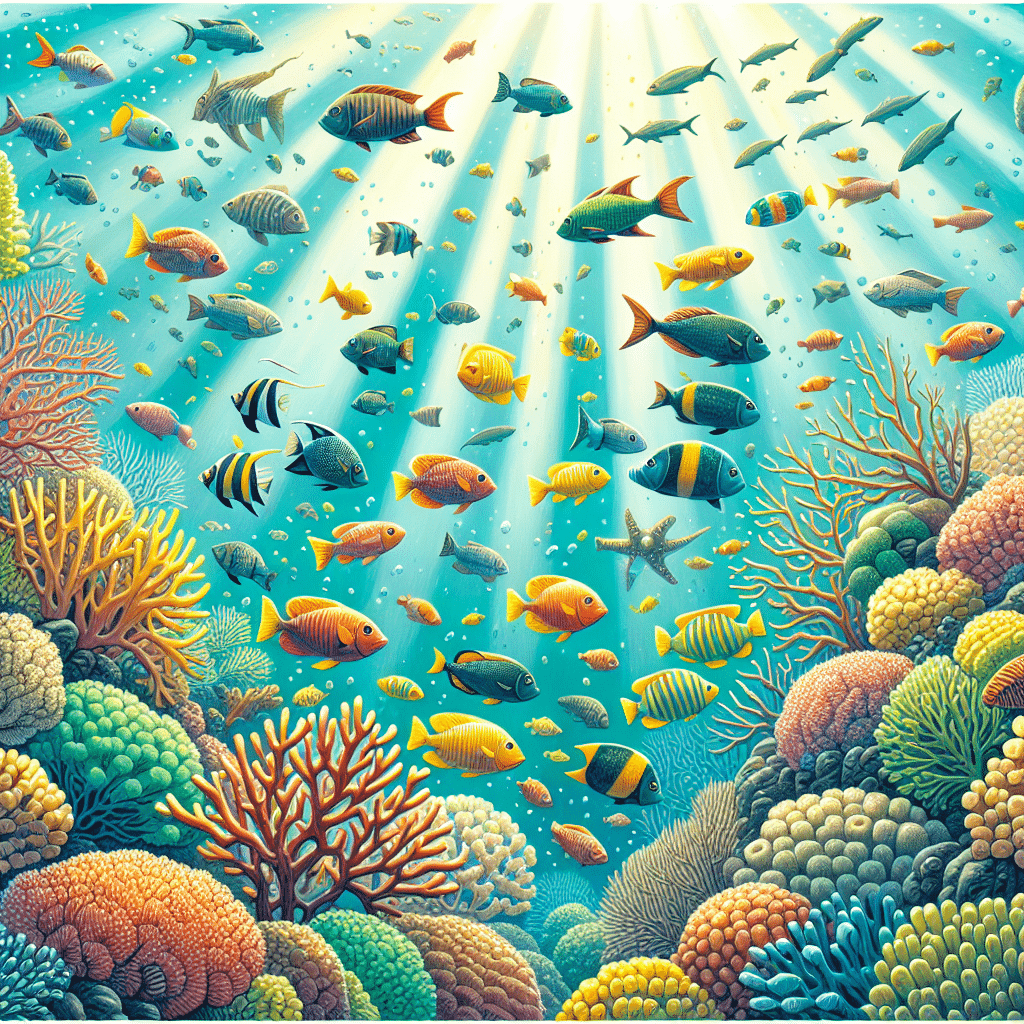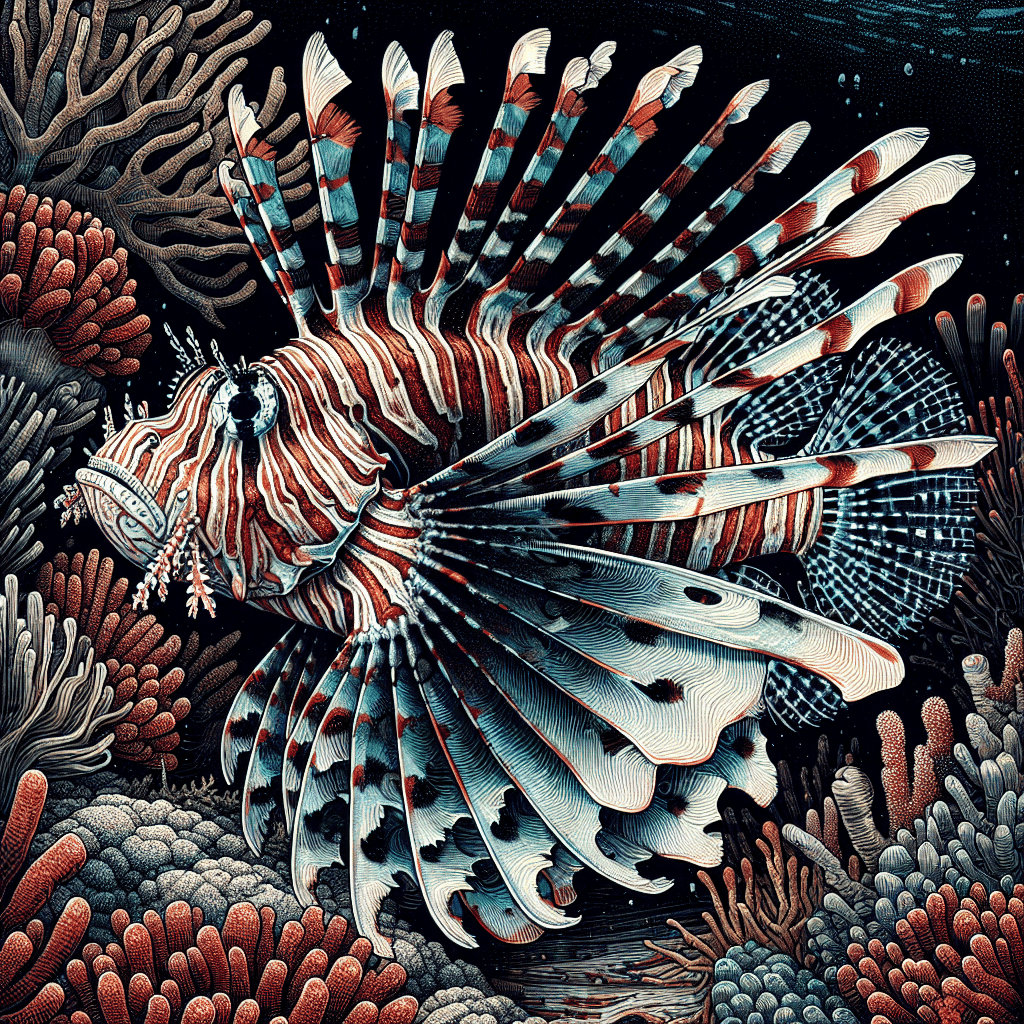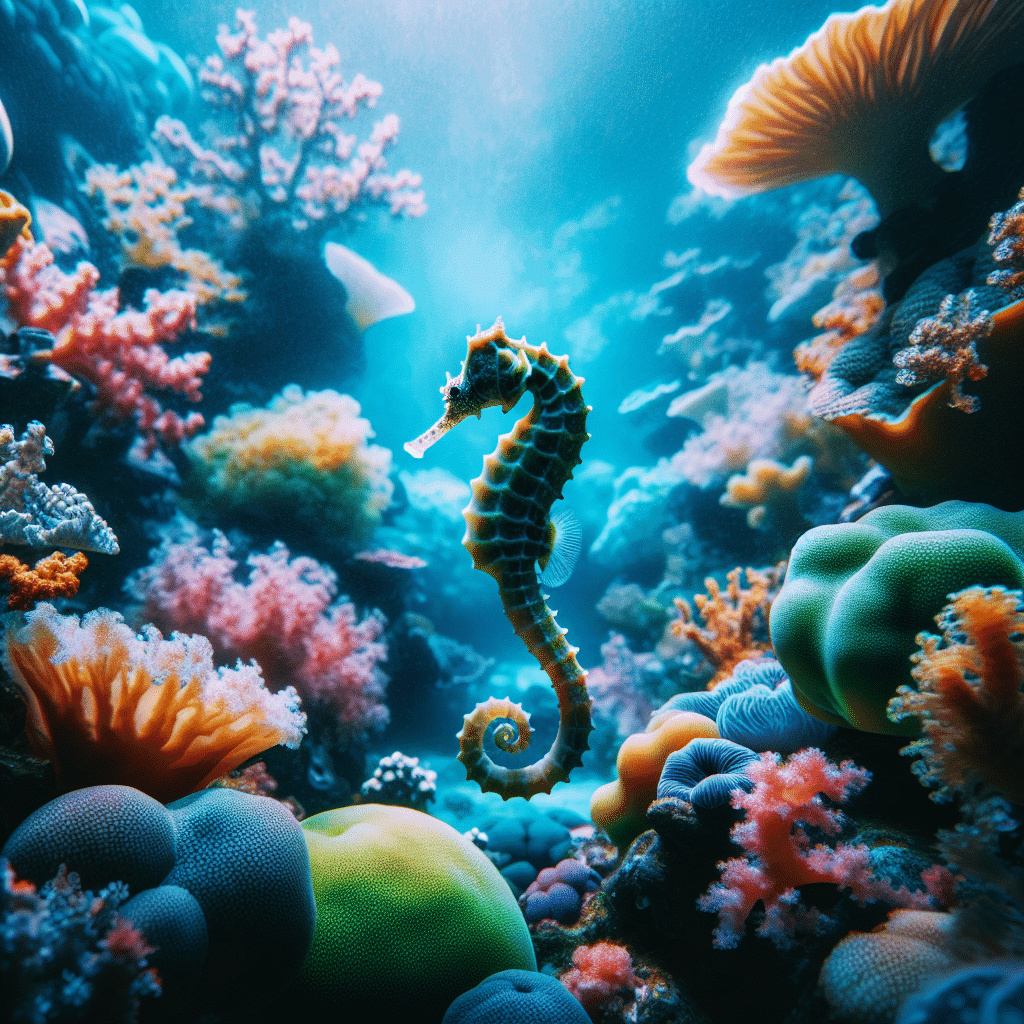Understanding Marine Fish
When diving into the world of marine fish, it’s fascinating to see how these creatures adapt to their salty environments and thrive in a variety of habitats.
Adaptation to Salinity
Marine fish have developed incredible adaptations that allow them to handle the challenges of living in salty water. Some fish can tolerate a range of salinity levels, while others need very specific conditions. For example, anadromous fish like salmon and shad live in saltwater but make their way to freshwater streams to spawn (Discover Boating). This ability to navigate between different salinities is one of the remarkable traits of some species.
Habitat Diversity
Marine fish are found in a wide range of habitats across the globe. Water covers about three-quarters of the Earth’s surface, and fish can be found in almost every aquatic environment. While the majority of fish live in saltwater, around 40% inhabit freshwater environments (Fish Nurture). This diversity allows various species to adapt to their unique surroundings, whether it be coral reefs, open oceans, or coastal areas.
Here’s a quick overview of different types of environments where marine fish thrive:
| Habitat Type | Description | Examples of Fish Species |
|---|---|---|
| Coral Reefs | Rich biodiversity, provides shelter and food | Clownfish, Butterfly Fish, Surgeonfish |
| Open Ocean | Vast, deep waters with varying temperatures | Tuna, Mackerel, Swordfish |
| Coastal Areas | Shallow waters, often nutrient-rich | Striped Bass, Bluefish |
| Estuaries | Where freshwater meets saltwater, rich in life | Salmon, Sea Trout |
Understanding how marine fish adapt to their environments and the diversity of their habitats is essential for anyone interested in keeping a reef tank. By choosing the right fish and providing the appropriate environment, I can create a thriving ecosystem in my aquarium. For more information on specific species, check out our links to clownfish, lionfish, and grouper.
Types of Marine Fish
When I’m diving into the world of marine fish, it’s fascinating to see the variety that exists. I love learning about the different types, especially how they adapt to their environments. Here’s a breakdown of the three main categories of marine fish: freshwater species, saltwater species, and anadromous fish.
Freshwater Species
Freshwater fish are those that live in rivers, lakes, and ponds. Surprisingly, only about 40% of fish species can be found in freshwater, while the majority thrive in saline environments. Some popular freshwater species include:
| Common Freshwater Fish | Description |
|---|---|
| Bluegills | Known for their flat bodies and blue-tinted fins. |
| Carp | Hardy fish that can grow quite large. |
| Catfish | Recognizable by their whisker-like barbels. |
| Trout | Popular among anglers, known for their colorful patterns. |
For more details on the best freshwater species for your tank, check out resources on freshwater fish care.
Saltwater Species
Saltwater fish are the stars of the ocean and are generally known for their vibrant colors and unique adaptations. Some well-known saltwater species include:
| Common Saltwater Fish | Description |
|---|---|
| Bluefish | Known for their aggressive behavior and sharp teeth. |
| Striped Bass | Popular among fishermen, these fish are known for their delicious taste. |
| Cod | A staple in many kitchens, known for its flaky texture. |
| Tuna | Fast swimmers and highly sought after for sport fishing. |
If you’re interested in caring for saltwater fish, be sure to explore our articles on caring for saltwater fish.
Anadromous Fish
Anadromous fish are a unique group that live in saltwater but make the journey upstream to freshwater to spawn. This fascinating life cycle includes species like:
| Anadromous Fish | Description |
|---|---|
| Salmon | Famous for their long migrations and pink flesh. |
| Shad | Known for their bony structure and high fat content. |
| Some Trout | Certain species swim upstream to reproduce. |
Anadromous fish are essential for maintaining the health of both freshwater and saltwater ecosystems. For more on their unique reproductive behavior, check out our section on reproduction of marine fish.
Understanding these different types of marine fish not only enhances my aquarium experience but also helps me make informed choices about fish care and compatibility within my tank.
Factors Affecting Fish Survival
When caring for marine fish in a reef tank, there are critical factors to consider that can impact their survival. Two of the most important elements are oxygen levels and the availability of cover.
Oxygen Levels
Oxygen levels in the water are crucial for fish survival. I always make sure to monitor these levels because they significantly affect the health of my fish. Several factors influence oxygen levels, including:
- Living Plants: They produce oxygen through photosynthesis.
- Oxygen from Surrounding Air: The exchange of gases at the water’s surface can also help maintain oxygen levels.
- Decaying Plants: These can deplete oxygen, so it’s essential to keep the tank clean.
- Pollution: Harmful substances can reduce oxygen availability, affecting fish health.
- Water Temperature: Colder water can hold more oxygen molecules than warm water, so I pay attention to the temperature in my tank.
Here’s a quick table showing how temperature affects oxygen levels:
| Water Temperature (°C) | Oxygen Saturation (mg/L) |
|---|---|
| 0 | 14.6 |
| 10 | 11.3 |
| 20 | 9.1 |
| 30 | 7.6 |
| 40 | 6.4 |
Understanding these factors is key to ensuring my fish thrive in the aquarium environment. For more information on the types of marine fish that thrive in different conditions, check out the section on common saltwater fish species.
Importance of Cover
Cover is another essential aspect for the well-being of my fish. This can include aquatic plants, rocks, logs, or any other structures in the tank. Here’s why cover is so important:
- Protection from Predators: Many fish species rely on cover to hide from potential threats, making them feel secure.
- Efficient Hunting: Cover provides hiding spots to ambush prey, which is vital for carnivorous fish.
- Reduced Stress: Having places to retreat can lower stress levels in my fish, leading to a healthier tank environment.
I always aim to create a well-structured tank that mimics the natural habitat of marine fish. By incorporating various types of cover, I can help ensure my fish are comfortable and safe. For tips on creating the perfect reef tank environment, explore more in our section on care tips for reef tank fish.
Common Saltwater Fish Species
As a reef tank enthusiast, I love the variety of marine fish available for my aquarium. Here are some common saltwater fish species that I often consider when setting up my reef tank.
Striped Bass
Striped bass, often called rockfish, are a favorite migratory species found along the east coast. These fish are known for their sleek body and are a longer relative of the white bass. They can be a great addition to a larger tank due to their active swimming nature.
| Striped Bass Facts |
|---|
| Average Size |
| Habitat |
| Diet |
For more information, check out striped bass.
King Salmon
King salmon, also known as Chinook, are one of the most popular saltwater fish species on the west coast. Their rich flavor makes them a favorite among anglers and fish enthusiasts alike. They thrive in cooler waters and can be a stunning centerpiece in a larger aquarium.
| King Salmon Facts |
|---|
| Average Size |
| Habitat |
| Diet |
For more details, visit king salmon.
Bluefish
Bluefish are migratory fish found along the East Coast, known for their sharp teeth. They are aggressive feeders and can be quite entertaining to watch. Bluefish thrive in open water and require ample space to swim.
| Bluefish Facts |
|---|
| Average Size |
| Habitat |
| Diet |
Learn more about these fascinating fish at bluefish.
Redfish
Redfish, also known as red drum, can be found from the Gulf of Mexico up the east coast of the Atlantic. They are popular for their distinctive coloring and are often sought after by anglers. They adapt well to various tank conditions and can be friendly tank mates.
| Redfish Facts |
|---|
| Average Size |
| Habitat |
| Diet |
For more information, visit redfish.
Pacific Halibut
Pacific halibut, known as the largest Pacific flathead, are popular saltwater fish species for pier and surf fishing. Their flat bodies and unique appearance make them a standout in any aquarium. They require a larger tank due to their size and need for swimming space.
| Pacific Halibut Facts |
|---|
| Average Size |
| Habitat |
| Diet |
To learn more, check out Pacific halibut.
These species are just a few of the amazing options available for marine fish in a reef tank. Whether I’m looking to create a lively community tank or focus on specific species, understanding these fish helps me make informed choices.
Feeding Habits of Marine Fish
Understanding the feeding habits of marine fish is essential for any reef tank hobbyist. It helps me provide the right diet for my fish, ensuring they thrive in my aquarium. Marine fish can be classified into three main categories based on their dietary preferences: carnivores, herbivores, and omnivores.
Carnivores, Herbivores, Omnivores
Carnivores: These fish primarily feed on other marine organisms. Their diets often include shrimp, plankton, and tiny crustaceans. Some examples of carnivorous fish include lionfish and grouper.
Herbivores: Herbivorous fish primarily consume plant matter. They eat things like algae and flowering seagrasses. Examples of these fish include tang and parrotfish, which help maintain the health of the reef by controlling algae growth.
Omnivores: Omnivorous fish eat both plant and animal matter. This flexibility allows them to adapt to different food sources in their environment. Common examples include clownfish and wrasse.
| Diet Type | Primary Food Sources | Examples |
|---|---|---|
| Carnivores | Shrimp, plankton, tiny crustaceans | Lionfish, Grouper |
| Herbivores | Algae, flowering seagrasses | Tang, Parrotfish |
| Omnivores | Both plant and animal matter | Clownfish, Wrasse |
Diet Variability
The dietary needs of marine fish can vary significantly based on their species and habitat. For instance, fish like bluefish and cod predominantly feed on plankton and macroalgae, which are essential for their growth (Fish Nurture). Predatory fish have more specialized diets, preying on organisms such as zooplankton, algae, fish eggs, sponges, and larvae (Fish Nurture).
In my reef tank, I find that providing a varied diet is key to keeping my fish healthy. I often mix high-quality flakes, frozen food, and fresh vegetables to ensure that all dietary requirements are met. This approach helps mimic their natural feeding habits and keeps my aquatic friends vibrant and active. For more information on specific fish diets, check out our articles on feeding habits of reef tank fish and diet variability.
Care Tips for Reef Tank Fish
Caring for reef tank fish can be an enjoyable and rewarding experience. Here are some essential tips to ensure that my aquatic friends thrive in their environment.
Tank Size and Environment
Choosing the right tank size is crucial for keeping marine fish healthy. A larger tank provides more stable water parameters, which is vital for the well-being of reef fish. Here’s a quick reference for tank sizes based on the species:
| Fish Type | Minimum Tank Size (Gallons) |
|---|---|
| Clownfish | 20 |
| Pufferfish | 30 |
| Tang | 75 |
| Anthias | 50 |
The environment also matters. A well-decorated tank with rocks, corals, and hiding spots creates a natural habitat, reducing stress and promoting healthy behaviors. It’s essential to use live rock and substrate that encourages beneficial bacteria growth, helping to maintain water quality.
Feeding Frequency and Variety
Feeding my reef fish a balanced diet is vital for their health. Most marine fish benefit from a varied diet that mimics their natural feeding habits. Here’s a general guideline for feeding frequency:
| Fish Type | Feeding Frequency |
|---|---|
| Carnivorous Fish | 2-3 times a day |
| Herbivorous Fish | 1-2 times a day |
| Omnivorous Fish | 2-3 times a day |
I like to include a mix of high-quality pellets, frozen foods, and live options to ensure they get the nutrients they need. For example, clownfish and tangs enjoy a diet rich in greens, while pufferfish may require protein-rich options like shrimp or fish.
Compatibility with Tankmates
Compatibility is key when selecting fish for my reef tank. Some species are more aggressive than others, and it’s essential to research each fish’s temperament before introducing them into the tank. For instance, while clownfish can be relatively peaceful, they may not do well with more aggressive species like certain types of grouper.
Here are some general compatibility tips:
- Peaceful Fish: Clownfish, gobies, and tangs often coexist well.
- Aggressive Fish: Triggerfish, lionfish, and certain pufferfish might not be suitable for community tanks.
- Mixed Species: Fish like anthias are best kept in groups and require constant feeding, while boxfish and pufferfish can be quirky but pose risks if not fed adequately (Wikipedia).
Creating a harmonious community in my reef tank leads to a more enjoyable experience for both the fish and me. For more information on specific fish types, feel free to explore clownfish, pufferfish, and grouper.
Reproduction of Marine Fish
Understanding how marine fish reproduce is essential for anyone interested in keeping them in a reef tank. I find it fascinating to learn about the different methods these fish use to ensure the survival of their species.
Fertilization and Development
Most marine fish reproduce sexually, and nearly all species have separate sexes. This means that male and female fish are distinct, avoiding self-fertilization by producing sperm and eggs at different times. Typically, fertilization occurs externally, which means the female lays eggs in the water, and the male then fertilizes them. This method is called oviparous reproduction (CK-12 LibreTexts).
In some fish species, like sharks, the fertilized eggs develop inside the mother’s body but without direct nourishment from her. These fish are ovoviviparous, meaning they give birth to live young that have developed from eggs inside their bodies (CK-12 LibreTexts).
After fertilization, fish eggs hatch into larvae, which look quite different from adult fish. The larvae swim around with a yolk sac that provides them with food until they undergo metamorphosis and develop into their adult form (CK-12 LibreTexts).
Spawning Behavior
Spawning is a fascinating behavior observed in many fish species. During spawning, a large group of adults gathers to release their gametes into the water simultaneously. This synchronized event increases the chances of fertilization and helps ensure that many embryos are formed at once. The more eggs produced, the higher the likelihood that some will survive to maturity, escaping the jaws of predators (CK-12 LibreTexts).
Some fish species engage in mouth brooding, where they carry their fertilized eggs in their mouth until they hatch. This behavior provides a form of parental care, helping to protect the developing young from predators (CK-12 LibreTexts).
Understanding these reproductive strategies can help me as a hobbyist create better environments for my fish. Whether it’s setting up a breeding tank or knowing what conditions promote spawning, this knowledge is invaluable for anyone looking to raise marine fish successfully.
Conservation of Marine Fish
Declining Populations
As a fish tank hobbyist, I’ve seen firsthand how important it is to understand the challenges facing marine fish populations. Many species are experiencing significant declines due to overfishing and habitat destruction. For instance, large pelagic sharks in the Northwest Atlantic, such as great whites and hammerheads, have seen population drops of over 75% since 1986. Similarly, the Atlantic cod, a historically pivotal fish for North Atlantic fisheries, has declined by as much as 99.9% in certain areas since the 1960s (BioScience).
The unsustainable exploitation of marine organisms is a major contributor to these declines. Overfishing practices have led to a dramatic increase in the number of overexploited fish populations, causing serious impacts on the ecosystem (Ocean52). The data shows that only 12% of marine stocks fully recover within 15 years after a population collapse, while 40% show little to no recovery (BioScience).
| Species | Population Decline (%) | Year of Decline |
|---|---|---|
| Large Pelagic Sharks | >75% | Since 1986 |
| Atlantic Cod | 99.9% | Since 1960s |
Recovery Efforts
Efforts to recover marine fish populations have shown that reductions in fishing mortality are essential. Populations tend to recover more rapidly when fishing pressure decreases following a collapse. On average, these populations return to about 39% of their pre-collapse size after such reductions (BioScience).
Various initiatives are being implemented to combat these challenges. These include establishing marine protected areas (MPAs), implementing sustainable fishing practices, and promoting awareness about the impact of overfishing. For me, supporting local fisheries that practice sustainable methods feels like a small but meaningful step in protecting these beautiful marine creatures.
As hobbyists, we can also contribute by choosing responsibly sourced fish for our aquariums and advocating for the conservation of marine ecosystems. Each small action can collectively make a significant difference in the health of our oceans and the survival of marine fish.



